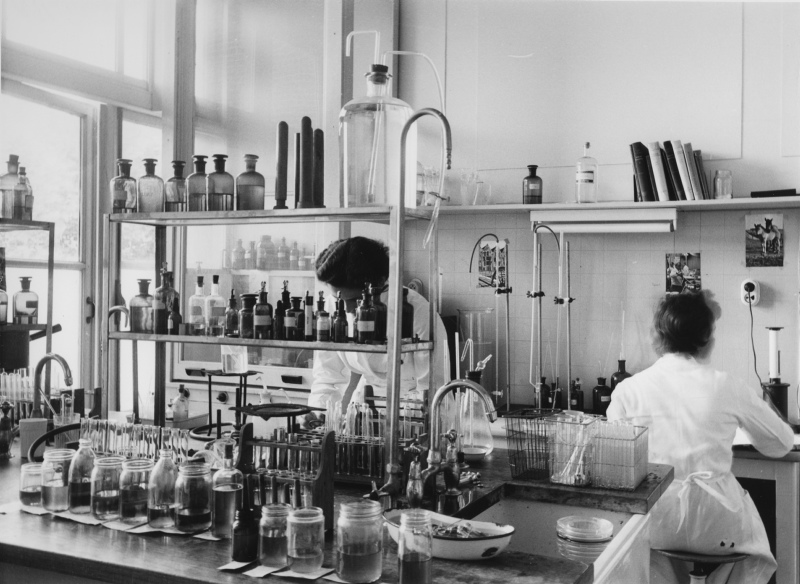
Photochemistry: How Photons Fuel and Fracture the World
By Noah Bussell
For many, light is an abstract entity—intangible, and seemingly lacking any physical might. Sure, it allows us to marvel at the night-time flickering of the Manhattan skyline or to save the good times as photographs, but these novelties aside, it is reasonable at first glance to assume that light can’t incite any productive chemistry. While many chemical reactions occur regardless of whether lights are turned on in the lab or if the sun is down, it turns out that the presence of external light can dictate the extent to which some important chemical reactions occur. These reactions are the focus of a branch of chemistry known as photochemistry, which studies how light absorption can induce chemical and physical transformations.
On a more fundamental level, electrons are often quantized into various energy levels, with higher energy levels being less favorable and accessible than lower energy levels. The energy that light carries can incite electrons to jump up to these unstable energy levels, allowing the system to harvest this energy for later use in chemical reactions.
In fact, chemists at Princeton University published a recent study in Nature Chemistry demonstrating that visible light could be used to help drive reactions that produce weak element-hydrogen (E-H) bonds—bonds that are very useful for synthetic chemists. Because these bonds are sometimes weak (i.e. they are high in energy and unstable), it is difficult for chemists to devise reactions that produce molecules containing these bonds. However, by shining light (of blue wavelengths for this experiment) on their system and utilizing metal catalysts, these scientists were able to excite electrons and thus incite E-H bond formation. Furthermore, they were able to implement this photochemistry in sequence with two other classes of reactions—concerted proton-coupled electron transfer (PCET), “whereby a proton and electron are transferred to a substrate in a single elementary step” (Park et al., 2021), and H2 splitting (which provides the source of hydrogen for the E-H bonds).
To summarize the process, metal catalysts would split molecular hydrogen, thereby forming metal-hydrogen (M-H) bonds. These catalysts with M-H bonds would then be excited by light, causing the M-H bonds to become reactive and thus enabling the hydrogen to break off and form a different bond—specifically the E-H bond via PCET. Fortuitously, the metal catalyst is regenerated and thus can split apart more molecular hydrogen, enabling the process to repeat. In surveying a range of catalysts and substrates, these scientists were able to demonstrate that by using light in conjunction with an iridium catalyst, a compound known as anthracene—used in dyes and semiconductor research—could hydrogenate with 47% yield. In contrast, this reaction was observed with less than a 5% yield under dark conditions.
Because the presence of these E-H bonds is so extensive, it is hard to predict exactly what sorts of applications these photochemical synthetic techniques may lead to, but the Princeton scientists postulated its usage in the energy sciences and, more fundamentally, as a synthetic tool for researchers. Nonetheless, photochemical reactions, in a broader context, comprise a large field of chemical research since these reactions may lead to new, sustainable chemistry and span energetic, biological, and atmospheric processes. As such, an understanding of this chemistry allows us to both think up new reactions and to make sense of the chemical activity occurring all around us. For instance, a class of molecules known as chlorofluorocarbons (CFCs) were shown by Mexican chemist Mario Molina to deplete the stratospheric ozone layer (a.k.a. the good ozone) upon absorbing ultraviolet light, inciting governments to introduce new environmental regulations.
Photochemistry also governs some chemistry occurring inside of the human body. As one example among many, while we do not directly ingest or metabolically produce the active form of vitamin D, we intake a precursor known as provitamin D. However, upon absorbing light, provitamin D is converted into another molecule (previtamin D), which then ultimately becomes vitamin D, allowing our body to retain calcium and our bones to stay healthy.
While the nature of light may be hard to grasp, it is a rather useful tool for synthetic chemists and is constantly interacting with the molecules around and inside of us. As such, an understanding of how to manipulate molecules with light provides scientists with fine control over reactivity, and thus the ability to devise new, sustainable techniques. From solar radiation to synthesis and biology, photochemistry will allow scientists to further produce useful compounds, as well as to make sense of, utilize, or counteract the less desirable processes around us.
References
Harvard T.H. Chan School of Public Health. (2012, September 18). Vitamin D. The Nutrition Source. https://www.hsph.harvard.edu/nutritionsource/vitamin-d/
McNeill, V. F. (2020). Mario Molina (1943–2020). Nature, 587(7833), 193–193. https://doi.org/10.1038/d41586-020-03133-3
Park, Y., Kim, S., Tian, L., Zhong, H., Scholes, G. D., & Chirik, P. J. (2021). Visible light enables catalytic formation of weak chemical bonds with molecular hydrogen. Nature Chemistry, 13(10), 969–976. https://doi.org/10.1038/s41557-021-00732-z
Reusch, W. (n.d.). Photochemistry. Virtual Textbook of Organic Chemistry. Retrieved October 31, 2021, from https://www2.chemistry.msu.edu/faculty/reusch/virttxtjml/photchem.htm
United Nations Environment Programme Ozone Secretariat. (n.d.). All about ozone and the ozone layer. Ozone and You. Retrieved October 31, 2021, from https://ozone.unep.org/ozone-and-you
United States Environmental Protection Agency. (2015, May 29). Ground-level ozone basics. Ground-Level Ozone Pollution. https://www.epa.gov/ground-level-ozone-pollution/ground-level-ozone-basics
Multimedia: https://www.thinglink.com/scene/1513988193718894595 (Visual adapted from: https://www.nature.com/articles/s41557-021-00732-z.pdf)
